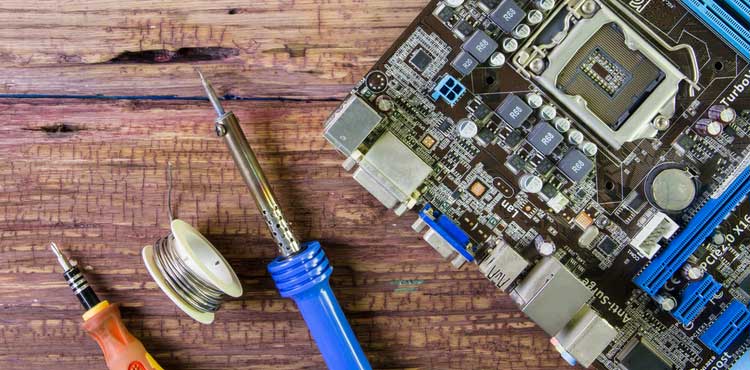How to start a successful computer repair business

The ability to configure a motherboard or coax a CPU into place are valuable skills, and those who have the technical chops can become a hot commodity. But what about tech experts who dream of being their own boss? If you have a knack for fixing electronics, starting a computer repair business could be a logical career move.
However, you shouldn’t take that decision lightly. Writing a business plan, securing financing, and taking several other key steps may be needed to put your best foot forward with your new IT company.
If you think you’re ready to open your doors and offer your tech expertise to customers directly, you can follow these helpful steps to successfully launch your computer repair business.
Step 1: Build up your savings
When starting a computer repair business, it’s important to shore up your savings to help cover the essentials before working with your first customer. These expenses may include:
- Purchasing your own tools and equipment
- Leasing a storefront
- Registering your business
- Paying for professional certifications, business licenses, and training
- Marketing materials, such as business cards, flyers, and online advertisements
On top of these startup costs, it’s also a good idea to keep emergency cash on hand. This gives you some flexibility as your company grows, as it can cover your business expenses during months when you don’t hit your billable work goals.
Ideally, you should keep enough money to cover your expenses for at least six months before quitting your day job and starting your own computer repair business.

Step 2: Create a business plan for your computer repair business
Your business plan will serve as the cornerstone of your small business – whether you run a laptop repair service from your kitchen table, or from the inside of a large IT repair and maintenance company with several employees.
When you write a business plan, it should include both your ideas for getting your new computer repair business up and running, as well as plans for how you’ll grow and adapt in the future. Here are some of the most important questions you should answer in your business plan to help guide your new company.
What services will you offer?
IT and computer repair is a broad field. Your business plan should include a “shortlist” of services that your computer repair company will specialize in. You could choose from several different specialties, including server maintenance, personal computer repair, and more.
Who is your target customer?
Deciding who your target customers are – individuals, businesses, or both – will help you better understand their needs and how your computer repair business can help them. Your business plan should include a profile of your target customers and a plan for reaching them.
What is your business structure?
How you choose to structure your business can affect both your taxes and legal liability. Most companies choose one of three options:
Where will you work?
Where you choose to conduct business will directly impact your expenses, business insurance needs, and customer relationships. For example, if you decide to offer computer repair services from your home, you’ll likely need a business vehicle and commercial auto insurance.
Most computer repairs companies operate from their own home, a storefront, or on-site with clients.
How are you financing your business?
Your business plan should include a strategy for financing your startup costs and operational expenses until you’re profitable. Some small business financing options include small business loans, partnering with outside investors, and crowdfunding.
Who are your competitors?
You should accurately analyze your competition in your business plan. Understand their strengths, weaknesses, and how you could fill a gap in your market. You should also note their marketing strategies and how they might make it difficult for your new computer repair company to gain traction.
What are your projected income and expenses for the first five years?
Setting goals in your business plan shows that you’re committed to your computer repair business. It forces you to consider the costs involved and develop a vision for where you want your company to go in the future.
What is your marketing strategy?
Your business plan should cover how you’ll get the word out about your new company. This section should include both your strategy and the costs associated with it. Consider attending networking events, email marketing, and SEO-based advertising to help you get started.
Do you plan on hiring employees?
Hiring employees can help take some work off your plate and allow you to scale your business. If you think you’ll hire employees eventually, your business plan should answer when you will look to hire, what business goals you need to hit to afford that, and what types of employees you'll need.
Step 3: Finance your computer repair business
After outlining your finance options in your business plan, the next step is to seek out what opportunities are readily available to help get your computer repair business off the ground.
To start, one option you can consider is a loan through the Small Business Administration (SBA). The SBA partners with lenders, community development organizations, and microlending institutions to set guidelines and facilitate loans for small business owners.
The SBA’s support reduces overall risk for lenders, making it easier for you to get approved for financing than you would through a traditional bank loan.
However, an SBA loan may not cover all your needs. In that case, you could try to leverage any of these options to provide additional support:
- Find an investor, such as a venture capital firm or angel investor
- Use small business credit cards
- Tap into your 401(k)
- Crowdfunding
- Borrowing from friends and family
Each of these options comes with risks. For example, credit cards typically have high interest rates compared to other business loans, and borrowing from friends and family risks damaging your personal relationships if your business should fail.
For this reason, you should try to run your computer repair business as lean as possible in the beginning. Doing so will minimize the amount of money you need to borrow and allow you to focus on building your business rather than repaying debt.
Step 4: Choose a location
Depending on the types of services you’ll offer, you could have a lot of location flexibility when you start your new computer repair business. For example, if you fix computers online, you may only need a home office with a secure internet connection to get started. Or, if you decide to offer on-site repairs, you may not need a physical location at all.
How you choose to operate will ultimately determine your location needs, which you’ll eventually choose from one of these three options:
Your home
Running a home business reduces your overhead since you don’t need to pay for office space. On top of that, your commute is nonexistent, and you typically have more flexibility over your work hours.
However, there are some downsides. It may be tough to separate your professional life and personal life. Also, if you ever work with your customers face-to-face (IT consultations, dropping off laptops for repair, etc.), you’ll either need to meet them somewhere else, or invite them to your home. You’ll also need to purchase commercial property insurance as most homeowner's policies don’t cover business property.
Because of this, running your computer repair business from your home is best if you fix computers online, offer in-home computer repair services, or work on-site with local businesses.
A storefront
A storefront lets people in your community see your business name and brand. It can draw foot traffic and gives you a set location to interact with customers who may be dropping off their computers for repairs or stopping in to ask questions.
The biggest downside of a storefront is the additional expense. Not only will you pay rent or a mortgage (if you decide to buy instead of lease), but you’ll also have other expenses such as utilities. On top of that, you’ll likely need to purchase general liability insurance and commercial property insurance to protect both you and your landlord from lawsuits and property damage.
If you include a retail section to sell computer accessories, you will also need to consider the wholesale costs of the products you plan to sell, as well as invest in product liability insurance.
On-site support
If you offer at-home computer repair services, you may not need a physical location for your business. Instead, you’ll go to your customers’ homes to repair their computers and troubleshoot other technical problems.
If you prefer to work with businesses instead of individuals, you can also run an on-site computer repair company where you’ll maintain their servers, install new hardware, and repair their company laptops and computers.
Limiting your repairs to on-site visits eliminates the added expense of a storefront while also separating your personal and professional lives. However, there are other factors to consider, including:
- Your customer’s scheduling constraints
- The possibility of jobs taking longer than expected
- Customers asking for extra work once you're already on location
- Transportation risks, such as car accidents or traffic delays
Since you’ll be driving to your customers, you’ll also need to purchase commercial auto insurance, since most personal auto policies exclude business-related driving.

Step 5: Set your pricing for your computer repair services
It can be tempting to offer below-market pricing when you first start out. However, this strategy can backfire. Your customers will expect your low prices to continue, making it harder to raise your rates in the future.
Plus, you run the risk of being seen as the “cheaper” option rather than the high-quality one. This could attract customers who are more interested in the cheapest rate than high-quality service. Once your rates increase, these customers could disappear, forcing you to build your customer base from scratch.
When you get into this low-price cycle, you’ll have to take on more customers to cover your business expenses and pay your salary.
Research the typical rate for other repair shops in your area and set your prices accordingly. You should aim to be in line with what your competition is charging, while also accounting for your own expenses.
Step 6: Get your computer repair and IT certifications
In most states, all you need to open a computer repair business is the expertise to do the work. However, you would likely benefit from obtaining certifications that prove your expertise and help you gain a competitive advantage. Some of the more common certifications for IT professionals include:
- CompTIA A+ Technician
- Cisco Certified Network Associate (CCNA)
- Certified Information Systems Security Professional (CISSP)
- Microsoft Certified Systems Engineer (MCSE)
- Apple Certified Macintosh Technician (ACMT)
- Building Industry Consulting Service International (BICSI) Technician
Certifications can help businesses of all sizes – from large commercial IT companies to freelance computer technicians. However, these credentials and courses aren’t one-size-fits-all. Check to see which certifications are popular among other repair shops in your area and search online for common certifications in your industry to learn about the latest trends.
Step 7: Market your computer repair business
Asking family and friends to spread the word about your new business can help you build some initial buzz, but you also need a comprehensive marketing strategy to help potential customers find you.
Your first priority should be creating a website for your computer repair business. Use the website to share information about what you do, who you work with, and how to contact you. Your website should be professional and mobile-friendly. To make sure it meets these standards, consider hiring a professional web designer to build it for you.
Your company website will also be your hub for search engine marketing (SEM), where you’ll optimize keywords and content on your site to help you show up in the search results when people look for terms like “computer repair company” or “freelance computer technician.”
But marketing doesn’t stop with your website. You’ll want to invest in other strategies as well. Some ideas for marketing a computer repair business include:
- Attending networking events with your target customers
- Joining a professional networking group
- Email marketing
- Promoting posts and ads on social media
It’s important to make marketing part of your regular schedule. Set aside a few hours each week to touch base with current and potential business clients, post on your social media accounts, and use email or other popular mediums to promote your business.

Step 8: Protect your computer repair business with small business insurance
Lawsuits and other catastrophic events can cost you a lot of money – and could even bankrupt your business. Fortunately, small business insurance for computer repair shops will help protect all your hard work. Here’s a breakdown of all the policies you should consider purchasing for your new business.
General liability insurance
General liability insurance is typically the first insurance policy any small business owner purchases. It covers many common issues that you might face, including:
- Third-party bodily injuries
- Third-party property damage
- Advertising injuries like libel, slander, and copyright infringement
If you rent an office space, your landlord will likely require you to carry this insurance policy as part of your lease agreement.
Commercial property insurance
Commercial property insurance pays to repair or replace stolen, lost, or damaged business property. It covers both your office space (whether your rent or own) and any property that you use for business purposes. You can also add to your commercial property insurance to cover things like:
- Natural disasters
- Forced closures due to property damage
- Damage to mobile property
Even freelance computer repair technicians, home-based computer repair companies, and mobile repair services should consider commercial property insurance since most homeowner's policies exclude business property from their coverage.
Business owner’s policy
Another policy that could benefit your computer repair business is a business owner’s policy (BOP). This insurance coverage combines general liability insurance and commercial property insurance at a discount, making it an ideal option for most computer repair companies – especially those who rent a storefront.
You can also add bailee coverage to your business owner’s or general liability policies to cover your customers’ property when they leave it in your care.
Errors and omissions insurance
Errors and omissions insurance (also called E&O insurance or professional liability insurance) covers lawsuits over the quality of your work. If a customer believes you either didn’t provide the services you agreed to, or made mistakes that cost them money, they could file a lawsuit against you.
Errors and omissions coverage pays for your legal fees, settlements, and other costs arising from the lawsuit.
Cyber insurance
Another critical policy for someone in your line of work is cyber insurance. This policy covers the cost of a data breach on your servers, or lawsuits when a customer blames you for failing to prevent a data breach on their computer. It pays for things like:
- Cyber extortion payments
- Data recovery
- Regulatory investigation and compliance
- Notifying affected customers
- Credit monitoring
- Business interruption expenses
Commercial auto insurance
If you travel to client sites, your personal auto policy likely won't cover an accident if you’re on company business. Most personal vehicle policies exclude business-related driving. Vehicles owned by a business must be covered by commercial auto insurance.
Or, you could invest in hired and non-owned auto insurance (HNOA), which covers accidents in personal, leased, and rented vehicles used for work purposes.
For example, if you or an employee gets into an accident while driving a personal car to drop off a laptop for work, your HNOA coverage would help pay for any claims or lawsuits against your business. It’s worth noting that this would not cover damage to the vehicle used by your business.
Fidelity bonds
Computer repair specialists who take on jobs with banks or other financial institutions may be asked by their clients to purchase a fidelity bond. Also known as an employee dishonesty bond, it functions as a voucher to ensure that you or your employees won’t use your behind-the-scenes access to steal money. If a theft does occur, the bond can repay the stolen funds.
Workers’ compensation insurance
If you have employees, it might be necessary to purchase workers’ compensation insurance, which can pay for medical expenses and disability benefits if an employee is hurt on the job. Whether or not you are required to buy it depends on where your business is based, since workers’ comp is governed at the state level.
If you're curious how much insurance might cost to protect your computer repair business, you can review Insureon’s estimates for IT businesses.
Complete Insureon’s easy online application today to compare insurance quotes from top-rated U.S. carriers. Once you find the right policy for your small business, you can begin coverage in less than 24 hours.
Christine Aebischer, Contributing Writer
Christine is a contributing writer who's experienced in a wide range of topics from personal finance and insurance to luxury lifestyles and wellness. She is an accomplished writer, editor, and content marketer with a specialization in service-driven content.









